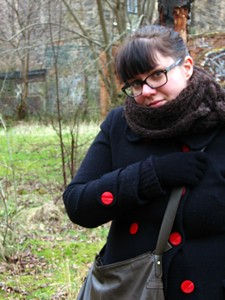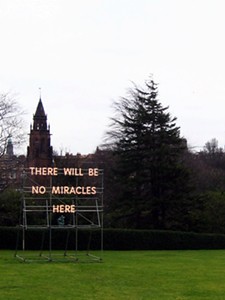February has been a good month so far. With several deadlines met, I now have a bit more time on my hands and this has resulted in a lot of crafting time which I have used well. Making: I have finished writing a brand-new shawl pattern which I hope you'll love as much as me! I have also finished knitting the sample shawl which has lived around my shoulders ever since. I'm yet to shoot the pattern photos as my model is currently overseas, but it won't be long until the pattern's released.
I have begun a lovely crocheted shrug in a new Rowan yarn, Creative Linen, in a gorgeous apple green. So far I am zipping through the shrug as the pattern's an easy two-row repeat. It'll be ace for wearing this summer. And I have a baby project lined up as my friend Katherine is expecting a boy very soon.
Mending: I finally took pity on my winter coat.
The coat is clearly on its last legs - in fact, it has been on its last legs the past three years - and I probably shouldn't even be seen wearing it in public. Unfortunately I have been unable to find its replacement (why is a classic pea-coat in warm navy or  black wool that hard to find?) and so I keep dragging it out of retirement.
black wool that hard to find?) and so I keep dragging it out of retirement.
Anyway, I sat down to repair the holes in it - I crocheted some small, decorative (and practical!) patches which I sewed on. Inspired by Kate I then replaced the dull black buttons with some lovely red vintage buttons. The coat is still on its last legs, but at least I don't feel totally embarrassed to be seen wearing it in public.
I have more mending to do: David's jumper has been worn non-stop for two years and the bottom rib is now in tatters and will need to be reknitted. Any tips on reinforcing ribbing?
Doing: I turned thirty-mumble-mumble yesterday and we went to Edinburgh for the day. We caught the FCB Cadell exhibition at the National Gallery of Modern Art before heading down to the refurbished National Portrait Gallery.
Cadell was one of the Scottish Colourists - a loosely bound group of painters working in the 1920s and 1930s. I'm easily excited by anything early 20th century (particularly 1914 to 1925-ish), so Cadell and his cohorts should be right up my street. The Colourists are a touch too post-impressionist for my taste, though, and although Cadell edged close to a sort of Matisse-esque Art Deco by the mid-20s, his work proved too polite and too safe for me. I left the exhibition feeling a bit grumpy because I have always admired Cadell's paintings in Glasgow's Kelvingrove Art Gallery and suddenly faced with a whole exhibition he felt wanting and limited. Maybe the curating was at fault - the transitions and contrasts in Cadell's style were never really explained and the obvious queer aspect to his art was not even mentioned.
The national Portrait Gallery has recently reopened and as a result the place was heaving.  We only had time to peruse a couple of the galleries - predictably enough I swooned over The Modern Scot (where I discovered William McCance - a painter and book designer clearly in artistic thrall to Wyndham Lewis) whilst David enthused over Romantic Scotland, a photography exhibition.
We only had time to peruse a couple of the galleries - predictably enough I swooned over The Modern Scot (where I discovered William McCance - a painter and book designer clearly in artistic thrall to Wyndham Lewis) whilst David enthused over Romantic Scotland, a photography exhibition.
I could write an entire blog post on the political implications felt throughout the Portrait Gallery - but I'm possibly too influenced by the novel I am currently reading - the very excellent And the Land Lay Still by James Robertson.
And so it goes.




 Shame has been marketed as a film about sex addiction and carries an 18 certificate (NC17 in the US) with much hype surrounding Michael Fassbender's nudity. I thought it was an intellectually engaging film - and very pointedly unerotic - and I don't buy that it is about sex addiction. The addiction is the symptom, not the cause.
Shame has been marketed as a film about sex addiction and carries an 18 certificate (NC17 in the US) with much hype surrounding Michael Fassbender's nudity. I thought it was an intellectually engaging film - and very pointedly unerotic - and I don't buy that it is about sex addiction. The addiction is the symptom, not the cause.